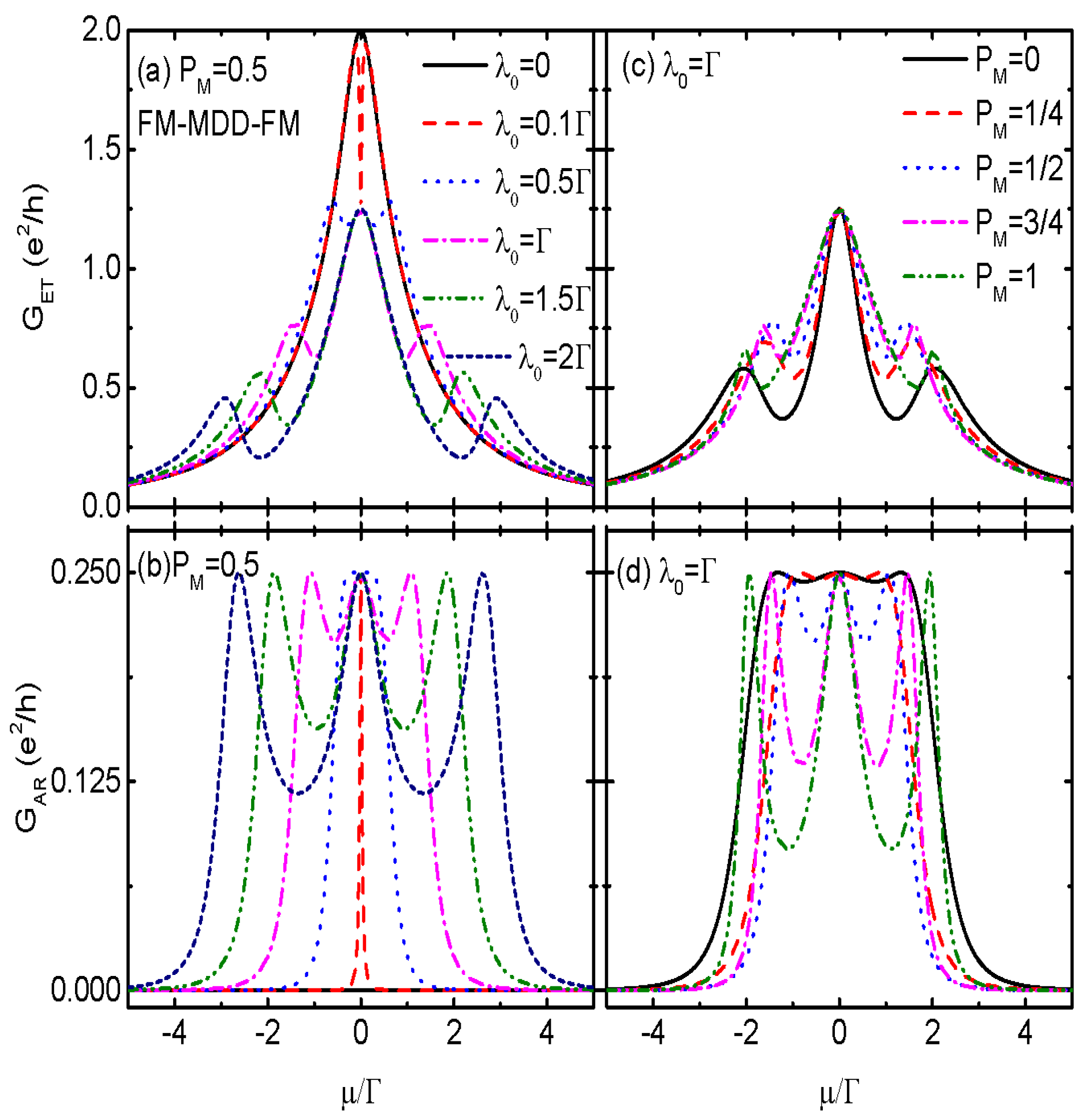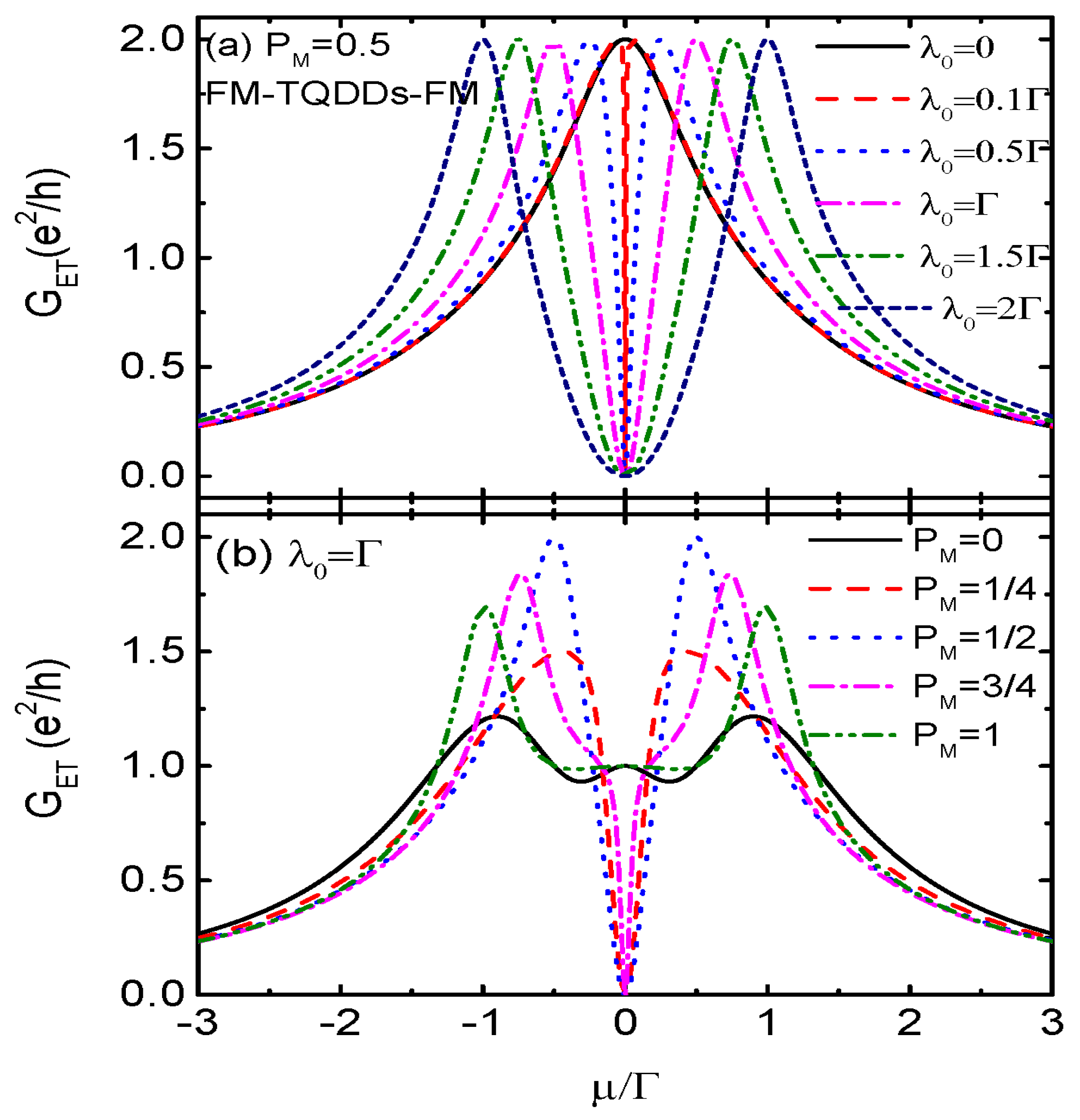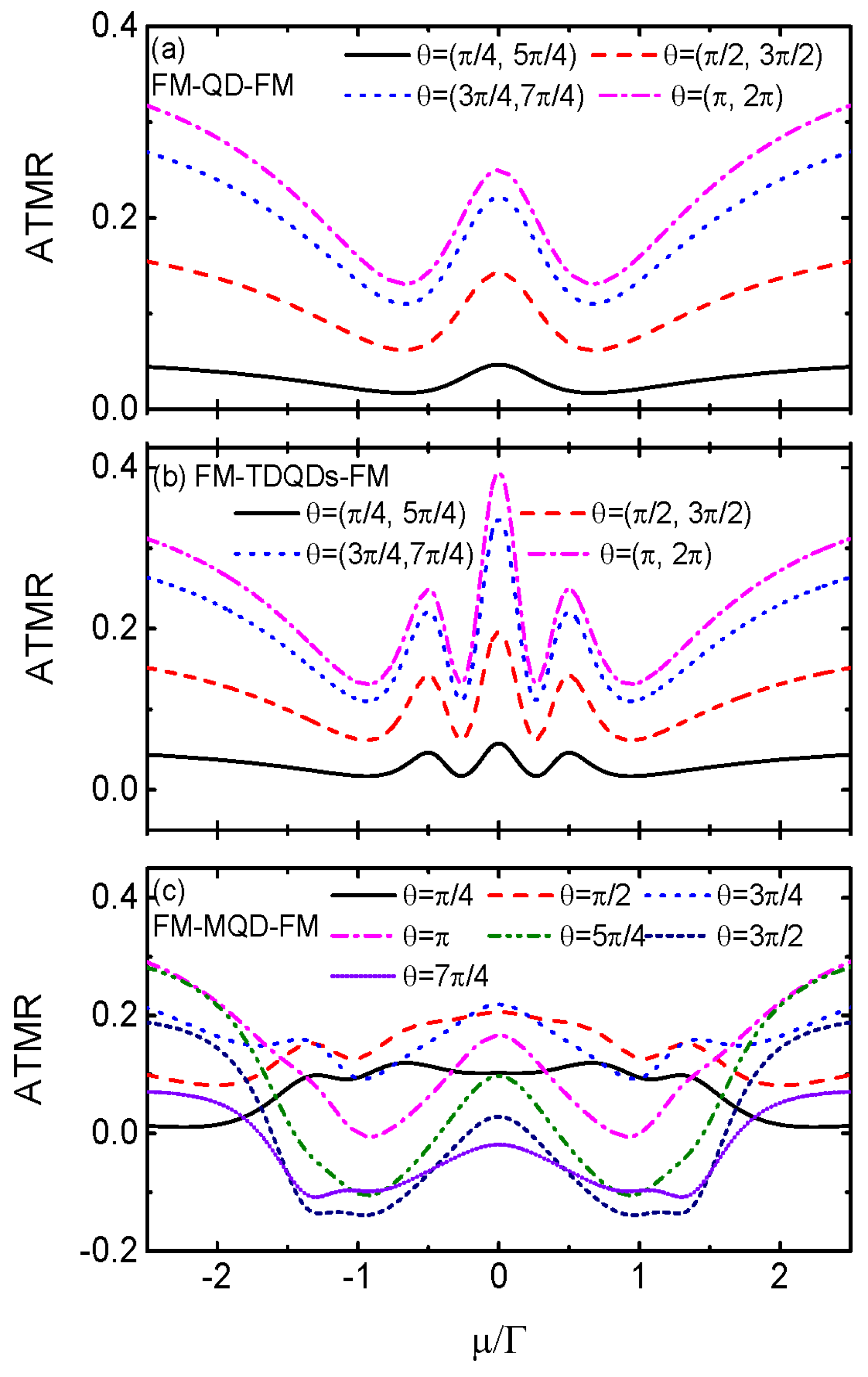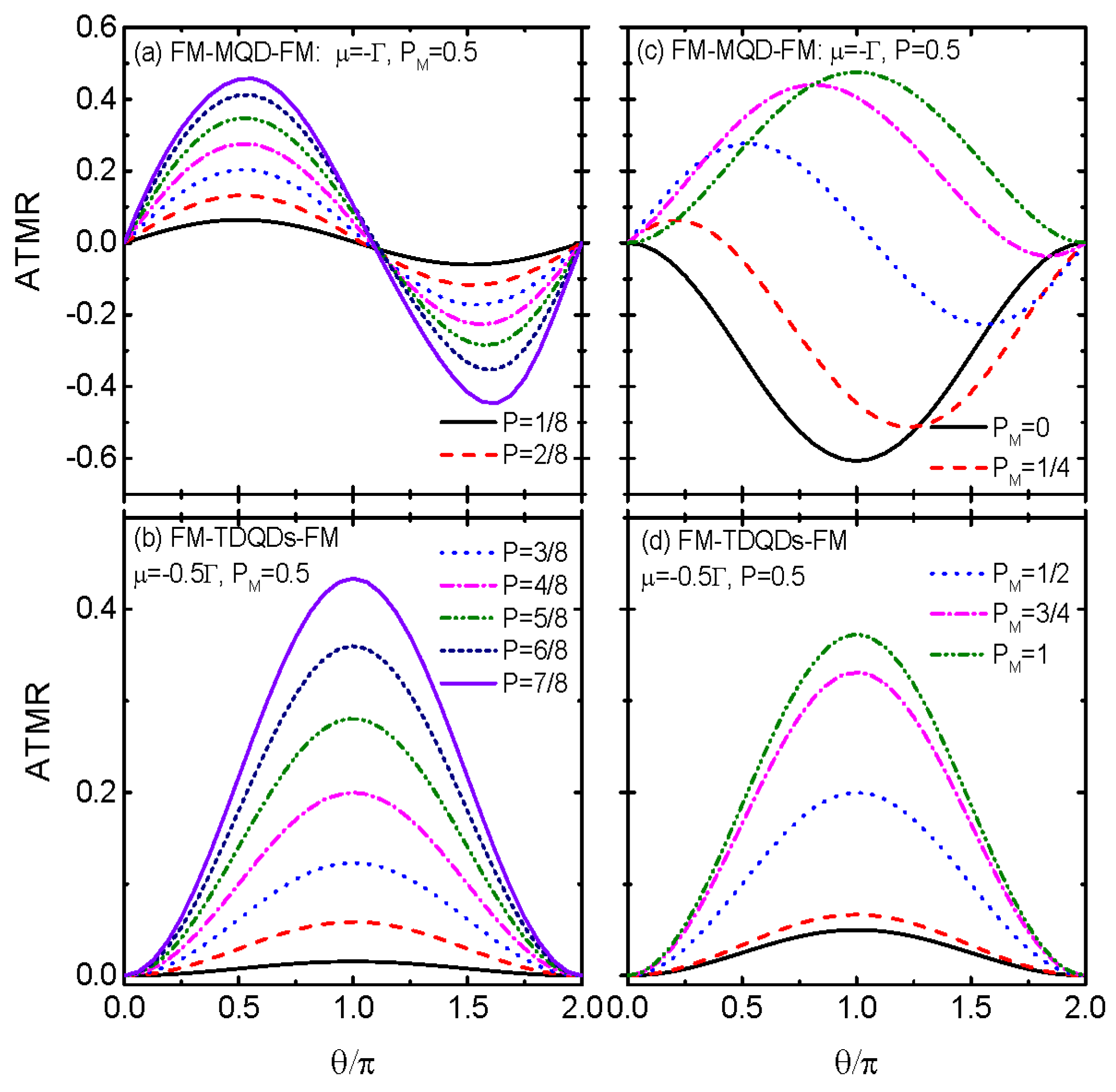1. Introduction
With the rapid development of information technology, there is a growing demand for information storage setups possessing faster response speed, lower energy consumption, and higher integration density. This is then continuously challenging the control methods and hosting materials of electrons’ spin degree of freedom in addition to their charge counterpart. In this context, much recent work has been devoted to the research subject of non-collinear magnetoelectronics, [
1,
2,
3] regarding to the manipulation of electron transport by the configuration changes of the magnetic moments in ferromagnetic [
4,
5,
6,
7,
8], antiferromagnetic [
9,
10], or ferrimagnetic [
11,
12] multilayers and tunnel junctions. In metallic ferromagnets, the differences between electronic bands and tunneling rates of electrons for majority and minority spins at the Fermi energy induce spin-dependent mobilities, and the directions of the magnetic moments in different ferromagnets are either parallel or antiparallel to each other. In the presence of applied electric fields and weak spin-flip scattering processes, a two-channel resistor model can be applied to explain the transport processes and spin-up and spin-down currents flow in parallel. When the magnetic moments of two ferromagnets are in noncollinear configuration (i.e., neither parallel nor antiparallel), the injected spin currents are also noncollinear and may induce spin states in the ferromagnets or the spacer between them pointing in arbitrary directions [
1,
2,
3,
7,
8], which is tunable by the device materials and noncollinearity angles. Correspondingly, the spin states prepared in the device and the spin currents transport through the system can be effectively modulated via the relative angles between the magnetic moments, and thus the instruments is called evocatively as spin valves.
Noncollinear ferromagnetic materials bring about unique physical phenomena that are absent in collinear ones, such as the interesting magnetoelectric coupling between the noncollinear spin states and spin spiral order, which may lead to the simultaneous broken of both spatial inversion symmetry and the time-reversal symmetry [
1,
2,
8,
9,
11,
13,
14]. It was shown that in system composed of a quantum dot (QD) sandwiched between the left and right ferromagnetic leads with noncollinear magnetizations (FM-QD-FM), the spin valve effect can serve as an effective modulation means of the subtle Kondo resonance, resonant tunneling and Coulomb blockade phenomena because the spin-polarized current carried by transport processes is variable by changing both the spin polarization and magnetizations of the ferromagnets [
4,
5,
15,
16,
17,
18]. The spin polarization and noncollinearity of the spin valve strongly affects the photon-assisted tunneling and thermoelectric processes when the FM-QD-FM is driven by a high-frequency ac voltage bias [
19].
In recent investigations, although as two conventionally antagonistic phenomena, the combination of ferromagnetism and superconductivity has attracted much attention since several intriguing novel effects emerge in the superconductor/ferromagnet heterostructures. It was found that a ferromagnetic nanowire can be driven to a nontrivial chiral topological superconducting state when it is deposited on a spin-orbit coupled superconducting substrate, and then a pair of Majorana bound states (MBSs) may be prepared at the ends of the nanowire [
20]. The massless and neutral MBSs are of their own antiparticles, and topologically protected. These exotic characters enable them promising in fault-tolerant quantum computation [
21,
22,
23]. Since the MBSs are realizable in superconductor/ferromagnet heterostructures in the absence of magnetic fields generally required in most of other schemes [
21], many similar platforms were put forward in recent years, such as unconventional superconductor/ferromagnet heterostructures [
24], ferromagnetic wires in proximixed to conventional superconductors [
25] and ferromagnetic chains with magnetic impurities deposited on top of conventional superconductors [
26]. Ferromagnetic metallic nanowire sandwiched between two conventional superconductors in proximity to ferromagnetic insulators were also proposed in theory to prepare the MBSs, a platform free from spin-orbit interaction and relies on the interplay of the supercurrents and exchange fields arising from the ferromagnetic insulators [
27,
28]. Very recently, it was found that topological superconductors with Majorana flat edge mode can be realized when noncollinear magnetic textures are in contact with the s-wave superconductor [
29].
In view of the successful applications of superconductor/ferromagnets heterostructures in preparation and manipulation of MBSs, here we study quantum transport through a QD simultaneously coupled to a nanowire hosting MBSs and two ferromagents individually acting as source and drain leads (FM-MQD-FM in
Figure 1). One of the motivations of the present paper is to exploit the possibility of detecting the existence of MBSs, an unsolved research issue yet [
21,
30,
31,
32,
33], by means of transport quantities related to materials’ magnetization, such as the tunnel magnetoresistance (TMR) [
11,
15,
17,
18,
34,
35,
36]. To distinguish the unique properties induced by the presence of MBSs, we compare the results obtained in this FM-MQD-FM with those when the QD is coupled to regular fermonic zero mode, such as another QD, a system denoted by FM-TDQDs-FM. Our numerical results find that the Andreev reflection (AR) processes induced by the MBSs exert strong impacts on the linear conductance and TMR, while leave the electron tunneling (ET) processes almost unchanged. The resonant peak value mediated by the MBSs in the presence of ferromagnetic leads are quite different from that when the QD is coupled to normal metallic leads. Especially, both the linear conductance and TMR are sensitive to the relative angles between the leads’ magnetizations. The TMR can even change its sign by the dot-MBS coupling, which is beyond the reach of coupling between QD and regular fermionic mode under similar parameters. This phenomenon thus may serve as detection method for the existence of MBSs. The present system is realizable within current nanofabrication technologies and may find use in superconductor/ferromagnets devices.
2. Model and Method
The structure studied here is described by the Hamiltonian of
[
4,
5,
36,
37,
38], in which
where the creation (annihilation) operator
is for electrons in the QD with spin-independent energy level
, which is tunable via gate voltage. The energy of conduction electrons with spin direction
and wave vector
k in lead
is denoted by
, where
is the amplitude of the magnetic moment in lead
[
4,
5]. In the present paper, we assume that the direction of the magnetic moment
of the left lead is aligned with the
z axis, while that of the right lead
has a tilted angle
with respective to
, forming a noncollinear magnetic configuration [
4,
5,
18,
19]. The quantity
in the Hamiltonian
is for direct hybridization strength between the MBSs with self-conjugate operators
, i.e.,
, and
[
37,
39,
40,
41,
42]. Here we consider that only one mode of the MBSs
is coupled to the QD with spin-dependent coupling strength
[
38,
41,
42]. The Hamiltonian
in Eq. (1) describes tunneling between the QD and the leads with amplitude of
. To proceed, we make make an unitary transformation to change the Majorana fermion representation to a conventional fermion one [
37,
41,
42],
and
. Then the total Hamiltonian is rewritten in a matrix form to calculate the Green’s functions needed for the electrical current through the QD. In the basis of
, the retarded Green’s function is calculated from the Dyson equation method as [
37,
41,
42,
43]:
in which
is the retarded Green’s function of the isolated QD and MBSs and
represents the self-energy due to QD-leads and QD-MBS couplings. The diagonal
is given by,
while
is
The self-energy
is contributed from coupling between the QD and the left/right ferromagnetic lead, with [
4,
19,
43]
where
is the spin-dependent coupling strength defined by
with
the density of states of spin
band in the left ferromagnetic lead. The matrix elements of
are individually given by [
4,
19,
43]
,
,
. The coupling strength between the QD and the right lead
is defined similarly to that of
, i.e.,
. The self-energy due to the dot-MBS coupling is as follows [
37,
38,
40,
41,
42]
and
is the transposed matrix of
(here we have assumed that
is real).
To calculate the current flowing through the system, one need also the lesser Green’s function for the electrons on the QD. We then extract the matrix elements in lines and columns from one to four from the Green’s functions in Eq. (2) to form the retarded Green’s function for the QD, i.e.,
. The
QD lesser Green’s function is then defined as
, where
is the advanced Green’s function and
the lesser self-energy contributed from the two leads. By applying the fluctuation-dissipation theorem, one obtains that
with the advanced self-energy
and [
43,
44,
45]
where
and
are individually the electron and hole Fermi distribution functions in lead
. In the above expression,
,
T and
denote chemical potential, system temperature and Boltzmann constant, respectively.
The electronic current
flowing from the left lead to the QD is obtained in terms of the Green’s functions of
and
as [
43,
44,
45,
46]
in which
, and
. In the present paper, we consider that an opposite bias
V is applied between the two leads,
. In such a case, we have
,
and only ET and local AR processes are allowed to occur [
43,
47]. Taking the explicit expressions of the above Green’s functions and self-energies into consideration, the current
is finally written as
in which the transmission of ET transport process is [
43,
44,
45,
46]
and
3. Numerical Results
In numerical calculations, the ferromagnetism on the leads is described by the spin-polarization parameter defined as [
4,
5,
18,
19]
. We then obtain
with
. In the present paper, we consider the case of the two leads are made of the same material having the same spin polarization, i.e.,
, and set
to be the energy unit. The spin-up and spin-down dot-MBS coupling strengths are also given with the help of a spin-polarization parameter
as
and
[
38,
41]. Moreover, we consider the zero temperature case which is favorable for the preparation of MBSs. Therefore, the linear conductances are
and
[
47]. In previous work on a spinless QD coupled to normal metal leads, the conductance peak at zero temperature is suppressed to be half of its quantum value
by QD-MBS coupling when the QD is on resonance and symmetrically coupled to the leads [
37]. Whereas if the dot is coupled to a regular fermionic zero mode (such as another QD), the conductance is suppressed to be 0 [
48,
49]. This a strong evidence of the existence of MBSs. One of the main tasks of the present paper is to examine how the conductance is changed when the QD is coupled to ferromagnetic leads, in particular when their magnetic moments are arranged in noncollinear configuration.
Figure 2 shows
and
varying with respective to the chemical potential
under the conditions of
,
and
. The spin-polarization of dot-MBS coupling is fixed to be
which means that spin-up and spin-down electrons are coupled to the MBS with equal strength,
. When the QD is decoupled from the MBSs (
), the system becomes to be FM-QD-FM and the ET conductance is characterized by a single-peak configuration. The central peak value of
reaches its quantum value
as indicated by the black solid line in
Figure 2a. Now the AR process is absence and
which is shown by the black solid line in
Figure 2b [
37,
47]. Turing on the QD-MBS coupling
and the system becomes to be FM-MQD-FM, the conductance peak of
in
Figure 2a is split and lowered to a fixed value of
. With increasing
, the peak height of
remains unchanged, with the two satellite peaks locate individually at
. In the presence of dot-MBS coupling, AR process occurs and
develops three peaks with equal height of
. Moreover, the peaks’ positions of
and
are the same. The height of the central peak in total conductance
. Since now electrons of the two spin directions couple to the MBS with equal strength
, we have
[
38], which is quite different from the case when the MBS is coupled to spinless QD in which
[
37,
47].
In fact, under this simple case, the analytical expression of the spin-dependent total conductance can be obtained as,
in which
. Results presented in
Figure 2 are in consistent with the analytical expression of
. Note that similar result was also found in system of the QD coupled to nonmagnetic leads and Majorana nanowire [
38]. In
Figure 2c,d we present
and
as function of the chemical potential for fixed
and different values of spin polarization
. Both of the two conductances remain the triple-peak configurations, and the the peaks’ values at
are also fixed as
is varied. As a result of it, the central peak value of the total conductance
G keeps at
regardless of the value of coupling strengths between the dot and the two spin components electrons. Under the conditions of strong asymmetric coupling with
and
, the values of
are individually
and
and the MBS couples only to one spin level of the dot. Assuming that spin-
electrons of the QD is coupled to the MBS, one finds the spin-dependent total conductance
which is independent of the dot level and dot-lead coupling strength, and
being in consistent with the result in FM-QD-FM [
5,
19].
To recognize the exotic characterize in the transport properties brought about by the MBSs, we present in
Figure 3 the conductance when the QD is coupled to another one behaving as a regular fermionic zero mode, and forms a T-shaped double QDs (TDQDs) configuration [
48,
49]. We denote the creation (annihilation) operator, energy level and coupling strength between the dots by the same symbols as those of the MBSs for the sake of consistency, and the Hamiltonian of the TDQDs is written as,
and the spin-dependent conductance is obtained as
which indicates that
in the cases of
as is shown by the black solid line in
Figure 3a. When the central QD is coupled to another dot (
), the single peak in
is split into two positioned at
, and the dip at
is suppressed to be zero. With increasing
, the heights of the two peaks in
G remain unchanged and are shifted toward negative and positive energy regimes, respectively. Note that in this TDQDs,
since the AR process is forbidden. These results are totally different from those of FM-MQD-FM presented in
Figure 2a [
37,
47].
We now study in
Figure 4 the angle
between the magnetizations of the left and right leads on the transport properties. When the QD is decoupled from the Majorana nanowire (configuration of FM-QD-FM), the line-shape of
varying with respective to chemical potential
at
in
Figure 4a is the same as the black solid line in
Figure 2a which is characterized by single-peak configuration. With increasing
from 0 (parallel configuation) to
(antiparallel configuration),
is monotonously suppressed which is the so-called spin valve effect [
4,
5,
18,
19]. This is induced by the difference between
(ingoing tunneling rate) and
(outgoing tunneling rate). When the magnetizations on the two leads are in parallel configuration (
),
and electrons of both the two spin components will tunnel resonantly from the left lead to the right one through the QD if
, and the total conductance reaches its quantum value
. For the case of noncollinearity angles
and the two leads are in antiparallel configuration, the ingoing and outgoing tunneling rates of the two spin directions are
,
, and
,
. This imbalance between the tunneling rates induces spin accumulation on the QD and suppresses the conductance amplitude. When the angle changes from
to
, the imbalance between the ingoing and outgoing tunneling rates of each spin component is reduced and the conductance is enhanced accordingly. Therefore, in this FM-QD-FM system the conductance obeys the relationship of
. As for the FM-TDQDs-FM system, the line-shape of the conductance
in
Figure 4b also resemble that in
Figure 3. There are two Breit-Wigner resonances in
and the dip at
is suppressed to be zero. Such a behavior of
remains unchanged regardless of the value of
, and also fulfills the the relation of
as in system of FM-QD-FM.
It is shown in
Figure 4c that the resonant peak of ET conductance in FM-MQD-FM resembles those in FM-QD-FM and FM-TDQDs-FM, except that the peak’s height becomes to be
as in
Figure 2. The behaviors of the satellite peaks are also unchanged by the value of
. As for the AR conductance in
Figure 4c, its line-shape is quite different from that of
, and the tripe-peak configuration at
is changed. Firstly, a dip in
emerges around
. Secondly, the triple-peak configuration reappears around
. Thirdly, the peak value around
is enhanced about to
other than the value of
for
and obeys the relationship of
. As a result of it, the dependence of the total conductance in FM-MQD-FM on the noncollinearity angle
is totally different from those in both FM-QD-FM and FM-TDQDs-FM, and can be used for distinguishing the MBSs from the regular fermionic zero mode.
The impacts of the MBSs on the transport processes can also be shown via the angle-dependent TMR (ATMR) besides the conductances [
15,
17].
Figure 5a presents the ATMR for the case of FM-QD-FM (
) varying as a function of chemical potential and different values of the noncollinearity angles. The ATMR is positive regardless of the values of the chemical potential and angle
, and is characterized by a resonant peak centered at
. It is monotonously enhanced when the angle is changed from 0 to
, and obeys the relationship of
[
15,
17,
18]. This is because that the magnitude of the conductance is monotonously suppressed during this process as is compared to the case of
. In the system of FM-TDQDs-FM, the behavior of the ATMR in
Figure 5b essentially resembles that of FM-QD-FM, but now the central peak is split into three due to the quantum interference effect. When the QD is coupled to MBS as shown in
Figure 5c, the ATMR depends on the angle
nonlinearly and even can change its signs. During the chemical regimes of
, the magnitude of the ATMR essentially first increases and then decreases with increasing
. For
, the ATMR value may change from positive to negative, which serves as a detection mean for the existence of MBSs. Moreover, the relationship between ATMR and the angle is
, which is quite different from that in the cases of FM-QD-FM and FM-TDQDs-FM.
In
Figure 6 we fix
, around which obvious negative ATMR emerges, and examine the variation of ATMR with respective to the angle
. When the QD is coupled to MBS as shown in
Figure 6a, the ATMR oscillates with respective to
in the form of a sinusoidal function. With increasing spin-polarization
P of the leads, the magnitude of ATMR is enhanced obviously with the sinusoidal line-shape remains unchanged. In contrast, the ATMR of FM-TDQDs-FM in
Figure 6b shows a broad Breit-Wigner resonance centered at
, and increases monotonously with increasing
P. The enhancement of the ATMR arises from the increased imbalance of the ingoing and outgoing tunnelling rates due to increased spin-polarization of the leads.
Figure 6c indicates that the ATMR is negative characterized by a broad Breit-Wigner resonance at
for
and
,
, i.e., the MBS couples only to spin-down electrons. With increasing
and the MBS couples to both of the two spin states on the QD, the absolute value of ATMR is suppressed and the resonance position is changed. Interesting, the ATMR in the case of
and the MBS couples only to spin-up state on the QD is totally opposite to that of
, i.e., ATMR
=-ATMR
. The ATMR for the case of FM-TDQDs-FM in
Figure 6d, however, is positive regardless of the value of
and remains as the single broad peak configuration.










